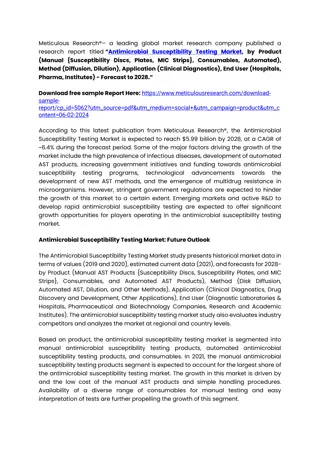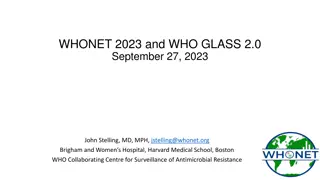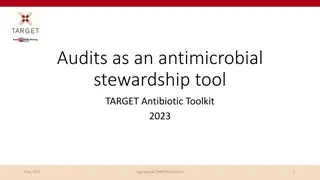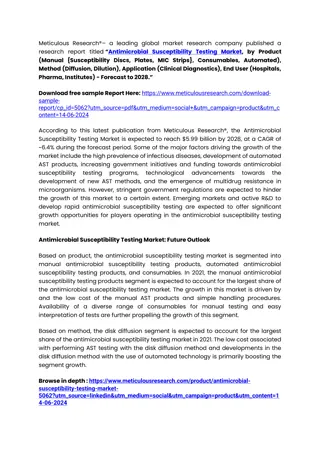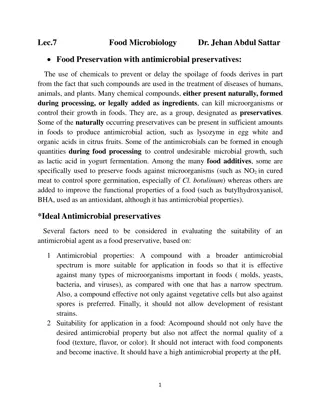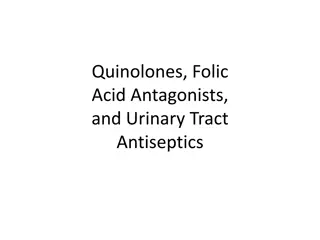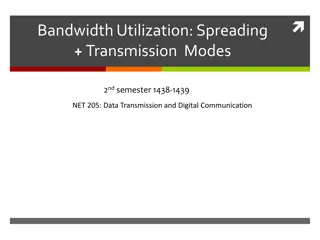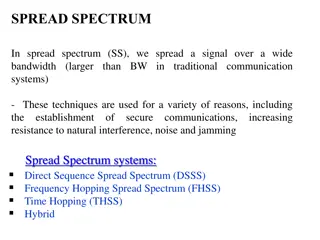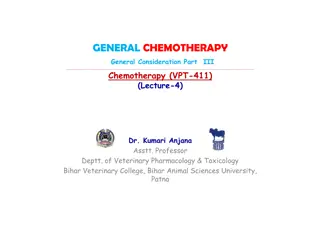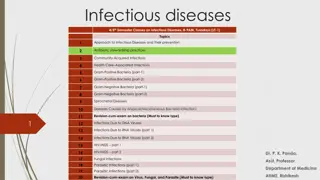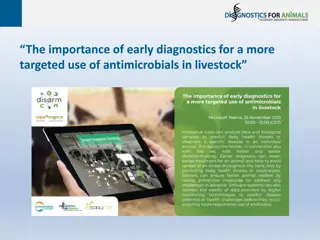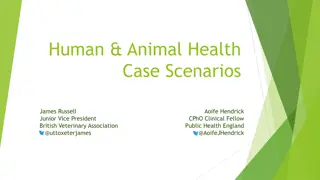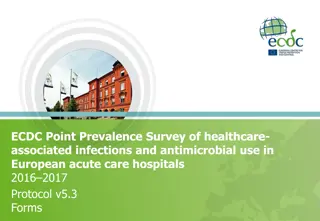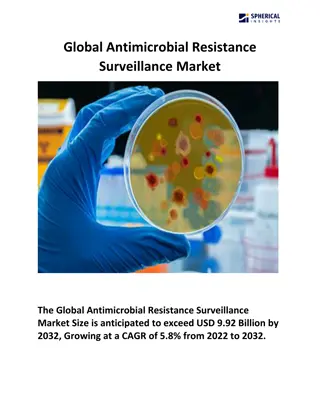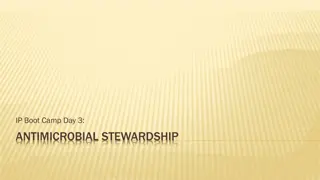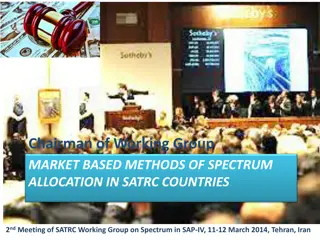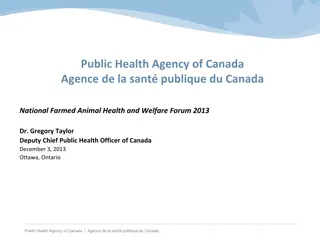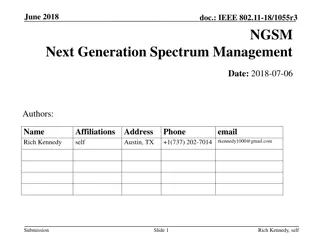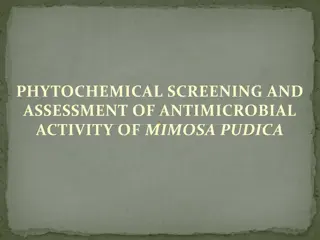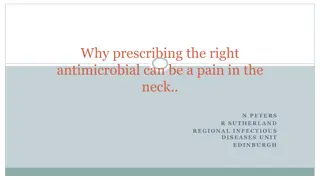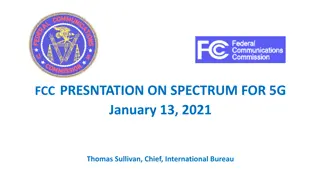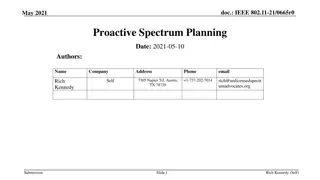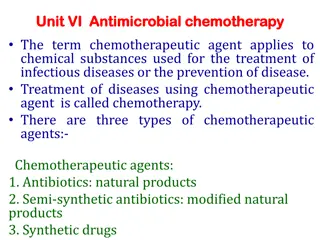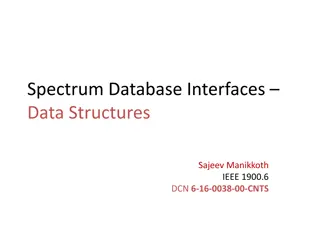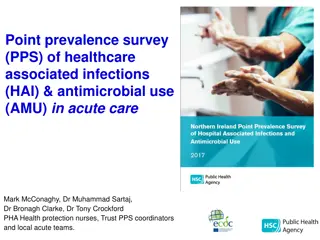Surgical Prophylaxis and Antimicrobial Selection Guidelines in Surgery
Surgical prophylaxis involves administering antibiotics before contamination of previously sterile tissues to prevent infections. Common pathogens in surgical site infections include skin flora like S. aureus. Antimicrobial selection is based on the surgical procedure, likely pathogens, and safety c
4 views • 19 slides
Antimicrobial Susceptibility Testing Market
Antimicrobial susceptibility testing (AST) is a laboratory procedure to identify the right antimicrobial regimen against microbes. Thus, AST of the causative agent(s) is essential for the timely selection of appropriate antimicrobial therapy.
2 views • 3 slides
Overview of WHONET: A Powerful Tool for Antimicrobial Resistance Surveillance
WHONET is a free software used worldwide for managing and analyzing microbiology laboratory data, with a focus on antimicrobial resistance. It offers features like %RIS analysis, MDR tracking, and outbreak detection, benefiting various sectors including healthcare, research, and policy-making. BacLi
7 views • 14 slides
Utilizing Audits for Antimicrobial Stewardship in General Practice
The importance of audits in antimicrobial stewardship is highlighted in this informative content covering topics like why audit and feedback are crucial, sources of prescribing data, available audit tools, practical tips, and a case study showcasing the positive impact of audits in UTI management. T
10 views • 40 slides
Antimicrobial Coatings Market: Exploring Sustainable Approaches to Microbial Con
The Antimicrobial Coatings Market is projected to reach $12.41 billion by 2031, at a CAGR of 10.8% from 2024 to 2031. The antimicrobial coatings help to keep surfaces pathogen-free by obstructing the growth of fungi, bacteria, and other parasites. Antimicrobial coatings provide long-lasting protecti
3 views • 4 slides
Antimicrobial Susceptibility Testing Market
Government initiatives for combating multidrug resistance are expected to boost the need for antimicrobial susceptibility testing products, thereby driving the growth of the global antimicrobial susceptibility testing market.
1 views • 2 slides
Trends in Gonococcal Resistance to Therapies in England and Wales Since 2011 Guideline Change
Antimicrobial resistance in Neisseria gonorrhoeae poses challenges for treatment. This study examines trends in ceftriaxone, azithromycin, and cefixime resistance since the 2011 guideline change in the UK. Data from the Gonococcal Resistance to Antimicrobial Surveillance Programme is analyzed to tra
0 views • 12 slides
Food Preservation with Antimicrobial Preservatives
Food preservation with antimicrobial preservatives involves the use of chemical compounds to prevent or delay food spoilage. These compounds, either naturally present or added during processing, can kill microorganisms or control their growth in foods. Factors for evaluating the suitability of an an
6 views • 8 slides
Spectrum Sensing for Enhanced Channel Access in Wireless Networks
This document presents a proposal for Spectrum Sensing Based Deferral (SSBD) to improve channel access in wireless networks. SSBD incorporates spectrum sensing with transmission deferral in a time-bound manner to enhance performance, reliability, and latency control. The proposed solution safeguards
1 views • 11 slides
Understanding Fluoroquinolones: Mechanism, Spectrum, and Generations
Fluoroquinolones are a class of potent antibiotics that act on DNA gyrase and topoisomerase IV in bacteria, leading to DNA damage and cell division interference. They exhibit a broad spectrum of antimicrobial activity, effective against various bacteria but not ideal for certain infections. Classifi
0 views • 18 slides
Understanding Spread Spectrum Techniques in Data Transmission
Explore the concepts of bandwidth utilization, spreading, and transmission modes in data transmission and digital communication. Learn about spread spectrum techniques such as frequency hopping and direct sequence spread spectrum, which enable efficient sharing of wireless communication channels. Di
1 views • 28 slides
Understanding Spread Spectrum Communication Systems
Spread spectrum techniques involve spreading a signal over a wide bandwidth for various reasons, such as secure communication, resistance to interference, noise, and jamming. This summary introduces Direct Sequence Spread Spectrum (DSSS), Frequency Hopping Spread Spectrum (FHSS), Time Hopping, and h
0 views • 25 slides
Ideal Antimicrobial Agents and Antimicrobial Classification Overview
This lecture on general chemotherapy outlines the properties of ideal antimicrobial agents, emphasizing selective and effective activity, bactericidal action, non-toxicity, and more. It also covers the classification of antimicrobials based on chemical structure, including sulfonamides, diaminopyrim
6 views • 19 slides
Overview of Epidemiological Cutoff Values (ECVs) in Antimicrobial Susceptibility Testing
Epidemiological Cutoff Values (ECVs) are crucial in determining antimicrobial susceptibility by distinguishing wild-type and non-wild-type microbial populations. ECVs are defined based on factors like minimal inhibitory concentration (MIC) and genetic variation, and are determined through specific m
0 views • 16 slides
Understanding the Role of Starter Culture in Fermented Milk Products
Starter cultures play a crucial role in the production of fermented milk products by producing antimicrobial compounds like organic acids, H2O2, CO2, aroma compounds, fatty acids, and bacteriocins. These compounds help prevent spoilage by inhibiting the growth of harmful bacteria and altering cellul
6 views • 9 slides
Combatting Antimicrobial Resistance: A Comprehensive Approach
Infectious Diseases class covers topics such as antibiotic stewardship, bacterial infections, viral diseases, and more. Cautionary statements by Sir Alexander Fleming underline the dangers of antimicrobial resistance, predicting millions of deaths and trillions in economic costs by 2050. The consequ
7 views • 30 slides
Advances in Antimicrobial Drugs: Selective Toxicity and Classification
The development of antimicrobial drugs has significantly improved therapeutics by controlling infections and preventing complications. These drugs target invading microorganisms using selective toxicity, sparing host cells. Antimicrobial drugs are classified based on site, mechanism of action, and c
0 views • 30 slides
Enhancing Livestock Health Through Early Diagnostics and Targeted Antimicrobial Use
Utilizing early diagnostics in livestock for targeted antimicrobial administration is essential for effective disease management and reducing antimicrobial resistance. This approach aids in timely treatment, facilitates monitoring of animal health status, and supports preventive measures against eme
0 views • 10 slides
Understanding Antimicrobial Stewardship in Healthcare
Exploring the critical aspects of antimicrobial stewardship, including the reasons for antibiotic resistance, considerations for prescribing antibiotics, stewardship checklists, and the role of toolkits in promoting responsible antibiotic use to combat resistance. The importance of monitoring, docum
0 views • 20 slides
ECDC Point Prevalence Survey of Healthcare-associated Infections and Antimicrobial Use in European Acute Care Hospitals 2016-2017 Protocol v5.3 Forms
This protocol outlines the data collection form for the ECDC Point Prevalence Survey focusing on healthcare-associated infections and antimicrobial use in European acute care hospitals during 2016-2017. The detailed form covers various aspects such as hospital information, infection control measures
0 views • 8 slides
Global Antimicrobial Resistance Surveillance Market
The Global Antimicrobial Resistance Surveillance Market Size is anticipated to exceed USD 9.92 Billion by 2032, Growing at a CAGR of 5.8% from 2022 to 2032.\n
1 views • 5 slides
ICAO Handbook on Radio Frequency Spectrum Requirements for Civil Aviation Workshops
This handbook provides insights into spectrum requirements for civil aviation workshops conducted in Egypt and Thailand in October 2016. It covers spectrum strategy, frequency management, spectrum overview for aviation, and frequency assignment planning to support the application of SARPs in Annex 1
0 views • 10 slides
Surgical Hand Antisepsis in the Operating Room Setting
Achieving effective surgical hand antisepsis is crucial in the operating room to reduce the risk of surgical site infections. This involves using antimicrobial agents and sterile brushes to remove debris and microorganisms, reduce microbial counts, and prevent rapid growth. The process requires equi
0 views • 21 slides
New EU Medicated Feed Regulations Lecture in Portugal, June 2024
Explore important elements of the EU Medicated Feed Regulations in a hands-on training for farmers and veterinarians in Portugal on June 6th and 7th, 2024. Learn about measures to combat antimicrobial resistance, EU legal frameworks on veterinary medicinal products, common rules for veterinary presc
0 views • 17 slides
Effects of Spicy Foods on Pathogenic Microbial Growth: A Study on Rosemary and Clove
Spicy foods like rosemary and clove have shown potential in inhibiting pathogenic microbial growth, which can help enhance food safety by reducing the need for chemical additives. This study explores the antimicrobial effects of these spices using microbial strains like Pseudomonas Fluorescens and S
0 views • 14 slides
Unified Pan-Spectrum Fitting Formula for Suprathermal Particles
Unifying spectrum formulas for suprathermal particles, the proposed pan-spectrum formula provides a versatile fitting method encompassing classic double-power-law, band function, and kappa distribution. Motivated by the need for more accurate spectrum information, the formula introduces five paramet
0 views • 14 slides
Understanding Antimicrobial Stewardship: Key Concepts and Importance
Explore the critical aspects of Antimicrobial Stewardship, including its definition, historical background, and the impact of antimicrobial resistance. Learn about the basics, such as the relationship between antimicrobial use and resistance patterns, as well as the importance of optimizing antimicr
0 views • 61 slides
Optimised Live/Dead Fluorescence Spectrometry for Antimicrobial Susceptibility Testing
This study focuses on the optimisation of live/dead fluorescence spectrometry for rapid antimicrobial susceptibility testing. The research uses fluorescent dyes to distinguish between live and dead cells, providing a potential method for quick antimicrobial resistance diagnostics. The experiment inv
0 views • 16 slides
Market-Based Spectrum Allocation Strategies in SATRC Countries
Explore the implementation of market-based methods for spectrum allocation in SATRC countries. Learn about the requirements, benefits, and challenges associated with adopting market-based mechanisms, especially in the context of increasing demand for spectrum and technological advancements. Discover
0 views • 41 slides
Complexities of Antimicrobial Resistance in Farm Animals and Public Health
The epidemiology of antimicrobial resistance is multifaceted, involving various sectors such as aquaculture, soil, wildlife, human-animal interfaces, and more. The case study on ceftiofur resistance in chickens highlights the impact of antibiotic use on resistance levels in both animals and humans.
0 views • 4 slides
Next Generation Spectrum Management Initiative Overview
Rich Kennedy presented on the need to change spectrum management practices within IEEE 802, addressing the results of straw polls conducted and proposing further investigation into Multi-band White Space feasibility. The presentation also highlighted the interest in advocating for an AI-managed spec
0 views • 14 slides
Phytochemical Screening and Antimicrobial Assessment of Mimosa pudica
This study explores the antimicrobial potential of Mimosa pudica extracts through phytochemical screening. Researchers investigated the leaves' antimicrobial characteristics and screened for phytochemical compositions to understand their effects on various microorganisms. The methodology involved sa
0 views • 18 slides
Challenges in Prescribing the Right Antimicrobial Agents
Prescribing the appropriate antimicrobial medication can be a daunting task due to various factors. In this case discussion, the patient is on multiple medications for different conditions, making it essential to carefully consider the choice of antimicrobial. Factors such as drug interactions, pati
0 views • 30 slides
Cognitive Radio Network and Game Theory Exploration at University of Houston
Explore the application of cooperative game theory in cognitive radio networks, focusing on spectrum sensing, dynamic spectrum access, and coalitional games. Detailed overview of research conducted at the Department of Electrical and Computer Engineering, University of Houston. Learn about cognitive
0 views • 42 slides
The Future of 5G: FCC's Spectrum Plans and Innovations
The FCC's presentation highlighted the importance of spectrum for 5G development, emphasizing the key components of their 5G FAST Plan. The plan focuses on pushing more spectrum into the market, updating infrastructure policy, and modernizing regulations to drive innovation and investment in the U.S
0 views • 12 slides
IEEE 802 Spectrum Planning: Proactive Approach for Improved Spectrum Management
Exploring the need for proactive spectrum planning in IEEE 802 to better manage the complex process of meeting spectrum needs efficiently and effectively. Delving into the challenges of spectrum allocation, sharing, and optimization to ensure that standards have the RF spectrum necessary for their r
0 views • 9 slides
Understanding Antimicrobial Chemotherapy Agents
Chemotherapeutic agents, including antibiotics, semi-synthetic antibiotics, and synthetic drugs, are used to treat infectious diseases. These agents should possess ideal characteristics such as selectiveness, broad antimicrobial spectrum, no side effects, and suitable bioavailability to be effective
0 views • 30 slides
Understanding Spectrum Databases and PAWS Parameters
Explore the world of Spectrum Databases and PAWS parameters, which provide essential information about available spectrum, permissible power levels, regulatory domains, geolocation data, and more. Learn about typical deployments, data types, and spectrum scheduling to enhance your understanding of s
0 views • 16 slides
Insights into Healthcare-Associated Infections and Antimicrobial Use in Acute Care Settings
This report presents findings from a Point Prevalence Survey (PPS) on Healthcare-Associated Infections (HAI) and Antimicrobial Use (AMU) in acute care, highlighting the prevalence rates, distribution of infections, changes in infection rates, and patterns of antimicrobial consumption across European
0 views • 17 slides
Managing Catheter-Related Bloodstream Infections in Vascular Access
Reduce and prevent catheter-related bloodstream infections in vascular access by addressing extraluminal infection sources and implementing strategies outlined in national drivers such as the NHS Long Term Plan and the Antimicrobial Resistance Action Plan. Recognize the importance of tackling antimi
0 views • 25 slides

